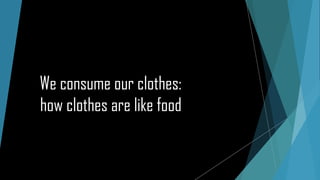We consume our clothes: how clothes are like food
- 1. We consume our clothes: how clothes are like food
- 2. DAILY activities have a cumulative effect Sleep Eat Dress
- 3. Daily choices about consumption are made under constant social pressure.
- 4. CONSTANT. PRESSURE. Gentlemen, youŌĆÖre hardly exempt.
- 5. Considering food, we learned to IGNORE EXTERNAL SOCIAL PRESSURE, and DEMAND DETAILS ABOUT THE VALUE CHAIN: Harvested responsibly?How? Humanely?Grown where? Locally?
- 6. Questions about FOOD = Questions about TEXTILES Where? How? Harvest conditions? Raw materials and labor come from the SAME SOURCES organic cotton growers in India
- 7. Processing Practices? Production conditions? Business Practices? Questions about FOOD = Questions about TEXTILES The EPA estimates just ONE cotton t-shirt requires 700 gallons of water during manufacture.
- 8. Repurpose? Recycle? Waste? Questions about FOOD = Questions about TEXTILES EPA estimates 13.1 million tons of textiles are trashed yearly; only 2 million tons are recovered for reuse or recycling.
- 9. Fibers derived from naturally occurring and sustainable earthly cycles with which we can partner. Petro-chemically derived atoms artificially formed into polymer plastic fibers. No natural cycle with which to partner. Growth cycle questions DO NOT APPLY TO SYNTHETICS NATURAL FIBERS SYNTHETICS O ŌĆō oxygen N ŌĆō nitrogen H ŌĆō hydrogen C ŌĆō carbon from: OIL COAL GAS
- 10. Polyester Nylon AcrylicHemp Wool Silk NATURAL FIBERS SYNTHETICS PET plastic Cotton
- 11. Synthetics inexpensive stay lightweight in the wet easy care Compelling for several reasons:
- 12. BUT -- Synthetics arrive & persist toxic & bio-accumulative consumed by animals + people shed MICROBEADS in the laundry UNESCO estimates there are 245 metric tons of plastic particles shed from fleece fabric per year globally
- 13. Fibers derived from naturally occurring and sustainable earthly cycles with which we can partner. Petro-chemically derived atoms artificially formed into polymer plastic fibers. No natural cycle with which to partner. REMEMBER: Growth cycle questions DO NOT APPLY TO SYNTHETICS NATURAL FIBERS SYNTHETICS O ŌĆō oxygen N ŌĆō nitrogen H ŌĆō hydrogen C ŌĆō carbon from: OIL COAL GAS
- 14. As with food, we can IGNORE EXTERNAL SOCIAL PRESSURE and DEMAND DETAILS ABOUT THE VALUE CHAIN of textile products.
- 15. Some comparatively responsible clothing brands:
- 16. +But the more fundamental questions/challenges are around buying LESS. +Purchasing more responsibly produced items made of natural materials are steps towards mainstreaming sustainable textiles and garments. +Instead of asking ourselves what to do with so much waste, letŌĆÖs ask how to create less waste.
















